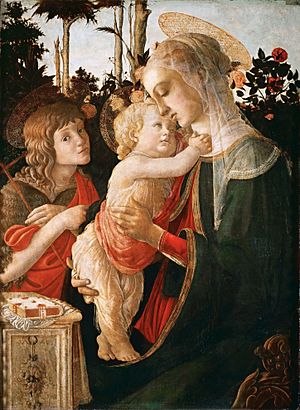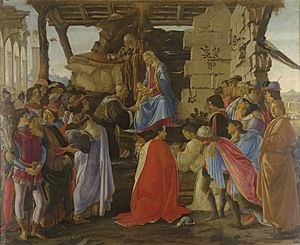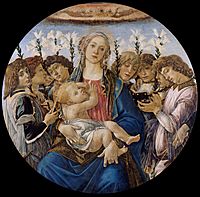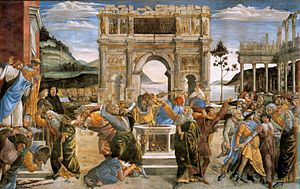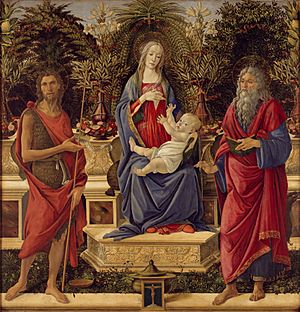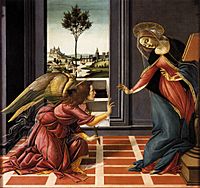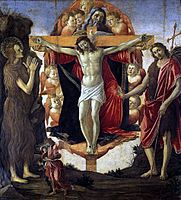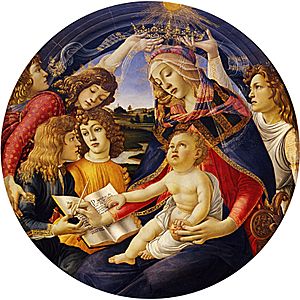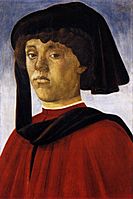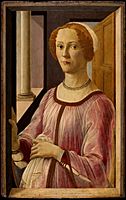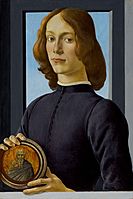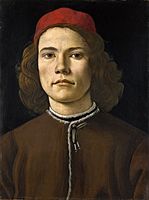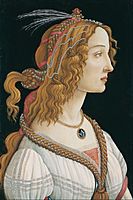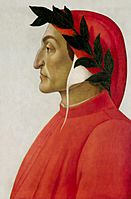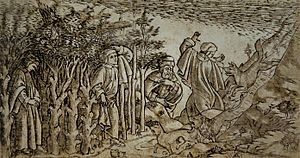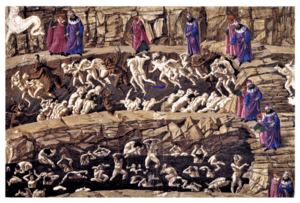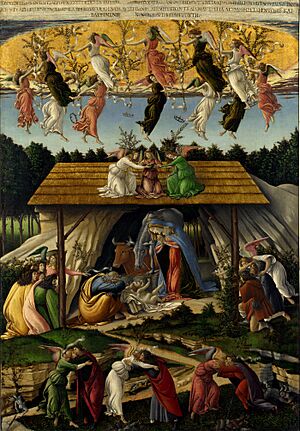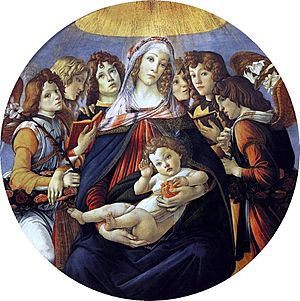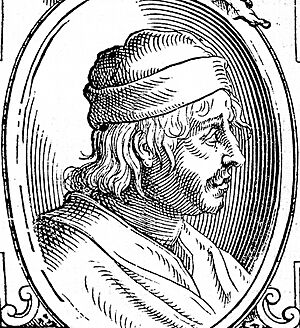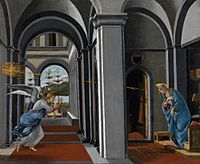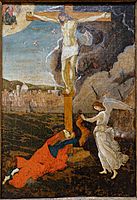Sandro Botticelli facts for kids
Quick facts for kids
Sandro Botticelli
|
|
|---|---|
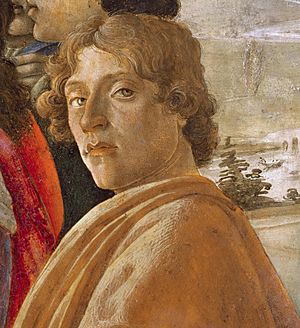
Probable self-portrait of Botticelli, in his Adoration of the Magi (1475).
|
|
| Born |
Alessandro di Mariano di Vanni Filipepi
c. 1445 Florence, Republic of Florence (now Italy)
|
| Died | May 17, 1510 (aged 64–65) Florence, Republic of Florence
|
| Nationality | Italian |
| Education | Filippo Lippi |
| Known for | Painting |
|
Notable work
|
Primavera The Birth of Venus The Adoration of the Magi Other works |
| Movement | Italian Renaissance |
| Signature | |
 |
|
Alessandro di Mariano di Vanni Filipepi (born around 1445 – died May 17, 1510), known as Sandro Botticelli, was a famous Italian painter. He lived during the Early Renaissance period. For a long time after his death, people didn't pay much attention to his art. But in the late 1800s, a group of artists called the Pre-Raphaelites rediscovered his work. Since then, his paintings have been loved for their beautiful lines and graceful style.
Botticelli is most famous for his paintings of ancient myths. But he also created many religious artworks, including dozens of paintings of the Virgin Mary and baby Jesus. Many of these were round, called tondos. His most well-known paintings are The Birth of Venus and Primavera. Both are displayed in the Uffizi gallery in Florence, Italy. Botticelli spent almost his entire life in Florence. He only left for a few months to paint in Pisa in 1474 and in the Sistine Chapel in Rome in 1481–82.
Only one of Botticelli's paintings, The Mystic Nativity (1501), has a clear date written on it. But experts can guess the dates of his other works from old records. This helps us see how his painting style changed over time. The 1480s were his most successful years. During this time, he finished his large mythological paintings and many famous Madonnas. In the 1490s, his style became more personal. His last works looked different from the new styles of artists like Leonardo da Vinci. Some people even say his later art looked more like the older Gothic style.
Contents
- Botticelli's Early Life and Training
- Becoming a Master Painter
- Painting in the Sistine Chapel
- Famous Mythological Paintings
- Religious Art After Rome
- Madonnas and Round Paintings (Tondos)
- Botticelli's Portraits
- Dante, Printing, and Manuscripts
- Botticelli and the Medici Family
- Botticelli's Later Years
- Other Art Forms
- Botticelli's Workshop
- Botticelli's Reputation Over Time
- See also
Botticelli's Early Life and Training
Sandro Botticelli was born in Florence, Italy. He lived in the same neighborhood, called Borgo Ognissanti, his whole life. He was also buried in his local church, Ognissanti. Sandro was the youngest of four children who grew up in his family. His father, Mariano di Vanni d'Amedeo Filipepi, was a tanner (someone who prepares animal hides). We don't know his exact birth date, but records suggest he was born between 1444 and 1446.
Around 1460, Botticelli's father changed jobs and became a gold-beater. This job often brought the family into contact with artists. An early writer, Giorgio Vasari, said that Botticelli first trained as a goldsmith.
The Ognissanti neighborhood was a simple area where many weavers and workers lived. But some rich families also lived there, like the Rucellai family. They were wealthy bankers. Botticelli's family rented their house from the Rucellai family.
In 1464, Botticelli's father bought a house nearby. Sandro lived and worked in this house from about 1470 until he died in 1510. His brothers also lived there. The Vespucci family were important neighbors. They included Amerigo Vespucci, who the Americas are named after. The Vespucci family were friends with the powerful Medici family and often hired Botticelli to paint for them.
The name Botticelli means "little barrel." It came from Sandro's brother, Giovanni, who was called Botticello because he was a bit round. By 1470, Sandro had fully adopted the name Botticelli for himself.
Becoming a Master Painter
Around 1461 or 1462, Botticelli became an apprentice to Filippo Lippi. Lippi was a leading painter in Florence and a favorite of the Medici family. From Lippi, Botticelli learned how to create beautiful, emotional figures with clear outlines. He also learned to use soft contrasts of light and shadow. Botticelli likely left Lippi's workshop by 1467.
Lippi died in 1469. By this time, Botticelli had his own workshop. In June 1469, he received a commission to paint Fortitude. This painting was part of a series of Seven Virtues that another artist had started. Botticelli's painting showed a more elegant figure and had more detailed decorations.
In 1472, Botticelli took on his first apprentice, Filippino Lippi, who was Filippo Lippi's son. It can be hard to tell Botticelli's and Filippino's works apart from these years. They often worked together, especially on paintings for wedding chests, called cassoni.
Important Early Paintings
Botticelli's earliest surviving large church painting is from about 1470–72. It shows the Virgin Mary and saints talking together. This painting shows how good Botticelli was at arranging figures naturally.
Another important work from this time is Saint Sebastian (1474). Botticelli painted it for a church in Florence. His saint looks calm and balanced. The body is drawn very carefully and correctly. The winter landscape in the background was inspired by art from northern Europe.
In 1474, Botticelli was asked to paint frescoes in Pisa. He worked there for a few months, but none of his work from Pisa survives. Still, being asked to paint outside Florence showed that his reputation was growing.
The Adoration of the Magi (around 1475–76) was praised by Vasari. It was in a popular church, which helped spread Botticelli's fame. This painting shows portraits of the powerful Medici family, including Cosimo and his grandsons Lorenzo and Giuliano. Most experts also believe Botticelli included a self-portrait in this painting. People admired the painting for showing many different faces and expressions.
Botticelli also painted a large fresco for the customs house in Florence. This painting, now lost, showed the leaders of the Pazzi conspiracy being hanged. This was a way to shame traitors in Florence. This important fresco commission may have led to him being called to Rome.
In 1480, the Vespucci family asked Botticelli to paint a fresco of Saint Augustine for their church. Another artist painted Saint Jerome facing it. Both saints were shown writing in their studies. This competition pushed Botticelli to do his best work. The fresco is now his earliest surviving one and is considered very fine.
-
Sacra conversazione altarpiece, c. 1470-72, Uffizi.
Painting in the Sistine Chapel
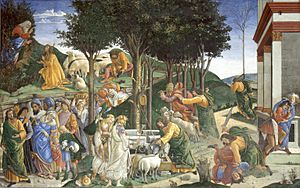
In 1481, Pope Sixtus IV invited Botticelli and other famous artists from Florence to paint the walls of the newly finished Sistine Chapel. This was a huge project to decorate the chapel. Most of these frescoes are still there, but they are often overshadowed by Michelangelo's later work. Some of Botticelli's original frescoes were even removed to make space for Michelangelo's paintings.
The paintings in the chapel told stories from the life of Christ and the Life of Moses. Botticelli painted three of the fourteen large scenes: The Temptations of Christ, Youth of Moses, and Punishment of the Sons of Corah. He also painted some of the imagined portraits of popes above these scenes. Each painter brought a team of assistants because there was so much to paint. The main panels are very large, about 3.5 by 5.7 meters. The artists finished the work in just a few months.
Botticelli's paintings in the Sistine Chapel often have a three-part design. He divides each scene into a main central group and two groups on the sides. In each painting, the main figure, Christ or Moses, appears several times. For example, Moses appears seven times in Youth of Moses. Botticelli was also likely in charge of designing the thirty portraits of early popes.
One of Botticelli's paintings, Punishment of the Sons of Corah, includes a very accurate copy of a classical Roman arch, the Arch of Constantine. This shows he was studying ancient art. In 1482, Botticelli returned to Florence. He did not travel far from home again after this.
Famous Mythological Paintings
The masterpieces Primavera (around 1482) and The Birth of Venus (around 1485) are not a pair, but people often talk about them together. Both are in the Uffizi gallery. They are among the most famous paintings in the world and symbols of the Italian Renaissance. These large paintings show subjects from classical mythology, which was very new for Western art at the time. Along with Venus and Mars and Pallas and the Centaur, these works have been studied a lot by art experts. They discuss how Botticelli copied ancient painters, how these works might relate to wedding celebrations, and the influence of Renaissance Neo-Platonism (a philosophical idea).
These paintings are complex, but they are also immediately beautiful. This is why they are so popular. The Primavera and Birth of Venus were seen by Vasari in the mid-1500s at a villa owned by the Medici family. For a long time, people thought both paintings were made specifically for that villa. But newer research suggests that Primavera was painted for a Medici townhouse in Florence. The Birth of Venus was likely commissioned by someone else for a different place.
Botticelli also painted a series of four panels for Antonio Pucci in 1483. These panels told the story of Nastagio degli Onesti from a famous book called Decameron. They were made for a wedding.
Religious Art After Rome
When Botticelli returned from Rome in 1482, his reputation was much stronger. He started getting more commissions for larger and more expensive religious paintings. The 1480s were his busiest time for religious art. By the mid-1480s, many top Florentine artists had left the city. Leonardo da Vinci moved to Milan in 1481. The Pollaiolo brothers went to Rome in 1484, and Andrea Verrocchio went to Venice in 1485.
The remaining leading painters in Florence were Botticelli, Domenico Ghirlandaio, and Filippino Lippi. They worked on a big fresco project for Lorenzo the Magnificent's villa. Botticelli painted many Madonnas, as well as altarpieces and frescoes in Florentine churches. In 1491, he helped decide on a design for the front of the Cathedral of Florence.
The Bardi Altarpiece
The first major church painting after Rome was the Bardi Altarpiece. It was finished by February 1485 and is now in Berlin. The frame was made by Giuliano da Sangallo, a favorite architect of Lorenzo the Magnificent. The painting shows the Virgin Mary and a large baby Jesus sitting on a stone bench in a garden. Plants and flowers surround them, creating a traditional setting for the Virgin Mary. Saints John the Baptist and John the Evangelist stand in front. Small ribbons with Bible verses explain the painting's meaning. Vasari praised the detailed and loving way it was painted.
The person who paid for the painting was from the important Bardi family. He had returned to Florence after working as a banker in London for over twenty years. Some parts of the painting might show influences from art in northern Europe.
The San Barnaba Altarpiece
A larger and more crowded altarpiece is the San Barnaba Altarpiece from about 1487. It is now in the Uffizi. In this painting, you can start to see elements of Botticelli's emotional later style. The scene is a grand heavenly room. The Virgin and Child are high on a throne, surrounded by angels. Six saints stand below the throne. Some figures have rather large heads, and baby Jesus is very big. The faces of Mary, Jesus, and the angels are beautiful. But the saints have varied and strong expressions.
Other Religious Works
After the late 1480s, Botticelli probably stopped painting large mythological works. He painted several altarpieces, and his workshop produced many Madonnas. Botticelli's largest altarpiece is the San Marco Altarpiece. It is the only one that still has all its smaller panels at the bottom. In this painting, the Coronation of the Virgin happens in a golden, colorful heaven. Angels dance and throw flowers.
In contrast, Cestello Annunciation (1489–90) has a darker background. The figures are bent in exaggerated poses, showing strong emotion. This painting also has a very detailed landscape seen through the window.
Botticelli painted two Lamentations (scenes of mourning over Christ's body). One is in a tall, narrow shape because it was painted for the side of a pillar in a church. It is now in Milan. The other is a horizontal painting, now in Munich. In both, many figures are crowded around the dead Christ. The Virgin Mary has fainted, and others support her and Christ. These paintings likely date from 1490 to 1495.
After about 1493 or 1495, Botticelli seems to have stopped painting large religious works. However, his workshop likely continued to produce Madonnas.
Madonnas and Round Paintings (Tondos)
Paintings of the Virgin Mary and baby Jesus were very popular in Italy in the 1400s. They came in many sizes, from large altarpieces to small paintings for homes. These smaller paintings were a steady source of income for artists.
Botticelli painted Madonnas throughout his career, until at least the 1490s. He was one of the first artists to use the round tondo shape. These round paintings were usually about 115 to 145 cm (four to five feet) across. Tondos were more common for palaces than churches. Many of Botticelli's Madonnas are in this round format. He often painted the tondo Madonnas himself, while his workshop might have handled the rectangular ones.
Botticelli's Virgins are always beautiful and idealized, like his mythological figures. They often wear rich, fashionable clothes. They are usually with beautiful angels or a young Saint John the Baptist. Some paintings include flowers, but none have detailed landscape backgrounds. Many of these paintings exist in several versions, with different quality levels. Botticelli or his workshop produced many of them. When people became interested in Botticelli again in the 1800s, his Madonnas were very popular.
In the Magnificat Madonna (around 1483), Mary is writing down the Magnificat. This is a speech from the Gospel of Luke where Mary speaks when she visits her cousin Elizabeth. She holds baby Jesus and is surrounded by angels who look like fashionable Florentine youths.
Botticelli's Madonna and Child with Angels Carrying Candlesticks (1485/1490) was sadly destroyed during World War II. It was stored in a safe place in Berlin, but a fire in 1945 destroyed it and many other artworks.
Botticelli's Portraits
Botticelli painted several portraits, though not as many as some people have thought. There are also idealized paintings of women that probably don't show a real person. These often look like the Venus in his Venus and Mars. Some people linked these to a famous beauty named Simonetta Vespucci, but this is unlikely.
Most of his small independent portraits show the person from the chest up. Women are usually shown from the side, while men are often shown in a "three-quarters" pose. The lighting is used to create shadows on one side of the face. The backgrounds can be plain or show an open window with only sky. A few have detailed landscapes. These portrait styles were common in Florence when Botticelli started his career.
Many portraits exist in several versions, often made mostly by his workshop. It can be hard to know for sure if Botticelli painted them himself. The backgrounds sometimes change between versions, but the person stays the same. The people in his male portraits have also often been wrongly identified, especially as members of the Medici family. Experts now believe he only painted about eight portraits of real people.
Botticelli sometimes slightly exaggerated features to make the person more recognizable. He also included portraits in other works, like his self-portrait and the Medici family in his early Adoration of the Magi. Some figures in the Sistine Chapel frescoes also seem to be portraits, but we don't know who they are.
-
Young Man, Pitti Palace, perhaps 1470-73.
-
Giuliano de' Medici, who was assassinated in 1478.
-
Portrait of a young woman, possibly Simonetta Vespucci, 1484.
-
La Bella Simonetta, also said to be of Simonetta Vespucci, c. 1480–1485.
-
Dante Alighieri, c. 1495.
Dante, Printing, and Manuscripts
Botticelli was interested in the great Florentine poet Dante Alighieri throughout his life. He even painted a portrait of Dante. Vasari said Botticelli wrote about Dante's work, but no such writing has survived.
Botticelli tried to design pictures for a printed book, which was new for a leading painter. He illustrated the first printed version of Dante's Divine Comedy in 1481. The engravings were made by a goldsmith named Baccio Baldini, based on Botticelli's drawings. There were supposed to be 100 illustrations, one for each part of the poem. However, only 19 were actually engraved. Baldini was not a very skilled engraver, so he couldn't capture the delicate style of Botticelli's drawings.
Botticelli later started a very fancy handwritten copy of Dante's Divine Comedy on parchment. Most of this manuscript only has the first pencil drawings, and only a few pages are fully colored. This manuscript has 93 surviving pages. It is now split between the Vatican Library and Berlin. This project was also never finished. Experts believe Botticelli worked on these drawings over a long time. Some scholars think Botticelli made this special book for himself.
Botticelli and the Medici Family
Botticelli is closely linked with the Florentine School of art. This was supported by the powerful Lorenzo de' Medici. Historians often call this period a "golden age" for art. The Medici family were the unofficial rulers of Florence during Botticelli's life, until 1494.
Lorenzo the Magnificent became the head of the family in 1469, around the time Botticelli opened his own workshop. Lorenzo was a great supporter of both art and literature. He encouraged a group of thinkers who influenced Botticelli's mythological paintings. Lorenzo himself didn't seem to commission many works directly from Botticelli. However, Lorenzo's younger cousins and other families allied with the Medici often hired Botticelli.
Giuliano de' Medici, Lorenzo's younger brother, was killed in the Pazzi conspiracy in 1478. Lorenzo barely escaped. Several portraits of Giuliano exist. They may have been painted after his death or shortly before.
Botticelli's Later Years
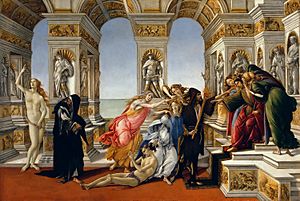
According to Vasari, Botticelli became a follower of Girolamo Savonarola. Savonarola was a strict Dominican friar who preached in Florence from 1490 until he was executed in 1498. Vasari claimed that Botticelli stopped painting because of Savonarola's influence and became very poor. However, modern art historians do not agree that Botticelli stopped painting entirely.
The Mystical Nativity, Botticelli's only painting with a clear date, was finished in late 1500. This was a year and a half after Savonarola died. We can see how Botticelli's style changed in his later works.
In late 1502, a few years after Savonarola's death, Isabella d'Este wanted a painting from Florence. Her agent wrote that Botticelli was available to start work right away. This suggests he wasn't in high demand, but he was still working.
Botticelli seems to have produced little work after 1501, or perhaps even earlier. His output had already slowed down after about 1495. This might be partly because he spent a lot of time on his drawings for the Dante manuscript. In 1504, he was part of a group that decided where Michelangelo's famous David statue would be placed.
In the 1490s, Botticelli returned to painting subjects from ancient history. These smaller works showed more figures and different scenes from each story. Examples include The Calumny of Apelles (around 1494–95) and the pair of The Story of Virginia and The Story of Lucretia (around 1500).
The Mystical Nativity is a relatively small and very personal painting. It shows figures of different sizes, with the Holy Family much larger than others. This might be a return to older Gothic art styles. The meaning of this painting is unique and likely very personal to Botticelli.
Another painting, the Mystic Crucifixion, shows Florence in the background. It seems to relate to the political changes in the city during that time. Unfortunately, it is very damaged.
Botticelli's later work, like the four panels showing Scenes from the Life of Saint Zenobius, shows smaller, more expressive figures. The colors are not natural, reminding some of the work of Fra Angelico from a century earlier. Some experts see hints of Mannerism in his later works, with their simplified emotions.
Botticelli continued to pay his dues to an artists' group until at least October 1505. He was over sixty years old by then. Vasari said Botticelli died "ill and decrepit, at the age of seventy-eight." He died in May 1510, but he was likely a bit younger than seventy at the time. He was buried with his family outside the Ognissanti Church. This was his local church, and it held his Saint Augustine in His Study.
Other Art Forms
Vasari mentioned that Botticelli made very fine drawings. Artists looked for these drawings after his death. Besides the Dante illustrations, only a few of his drawings survive. None of them are directly linked to his finished paintings.
Botticelli also designed embroidered patterns for three church clothes. He also created a new way to decorate banners for religious parades.
Botticelli's Workshop
In 1472, records show that Botticelli had only Filippino Lippi as an assistant. By 1480, he had three assistants. Many works, especially Madonnas, are said to be by Botticelli's workshop. This usually means Botticelli did the initial drawing, and his assistants finished the rest. Or, the assistants copied his drawings.
Botticelli's style, with its clear lines, was relatively easy to copy. This makes it hard to tell who did what in some works. However, the high quality of Botticelli's own drawing usually makes works done entirely by others easy to spot. Experts still debate who painted certain parts of many works.
The National Gallery in London has an Adoration of the Kings from about 1470. They say it was started by Filippino Lippi but finished by Botticelli. This was unusual for a master to take over a student's work.
Botticelli's Reputation Over Time
After he died, Botticelli's fame faded for a long time. His paintings stayed in the churches and villas where they were made. His frescoes in the Sistine Chapel were overshadowed by Michelangelo's later works.
Vasari's book, Lives of the Artists, is the main source of information about Botticelli's life. However, Vasari's view of Botticelli was not very positive. He saw Botticelli as an artist who wasted his talent in his later years. Vasari was born the year after Botticelli died, but he would have known many people in Florence who remembered him.
In the 1800s, people started to rediscover Botticelli's art. The Birth of Venus was displayed in the Uffizi from 1815. The Berlin gallery bought the Bardi Altarpiece in 1829. The National Gallery, London bought a Madonna (now thought to be by his workshop) in 1855.
The English collector William Young Ottley bought Botticelli's The Mystical Nativity in Italy in 1799. But when he tried to sell it in 1811, no one wanted to buy it. Later, it was shown in a big art exhibition in Manchester in 1857. Over a million people saw it there. Botticelli's Venus and Mars was bought by the National Gallery in 1874 for a modest price. In recent years, his paintings have sold for very high prices. For example, the Rockefeller Madonna sold for over $10 million in 2013. In 2021, the Portrait of a Young Man Holding a Roundel sold for over $92 million.
The Pre-Raphaelite Brotherhood in England were inspired by Botticelli's work. Writers like Walter Pater also helped make Botticelli famous again. The first book about Botticelli was published in 1893. Between 1900 and 1920, more books were written about Botticelli than any other painter.
Botticelli appears as a character in many stories and TV shows about 15th-century Florence. He was played by Sebastian de Souza in the TV series Medici: Masters of Florence.
An asteroid discovered in 1996, 29361 Botticelli, is named after him.
-
Mystic Crucifixion, Fogg Art Museum.
See also
 In Spanish: Sandro Botticelli para niños
In Spanish: Sandro Botticelli para niños




